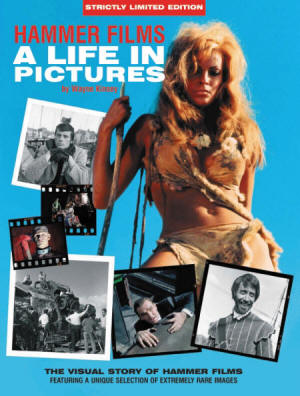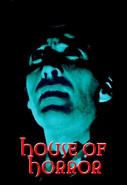|
 Wayne
Kinsey has easily cemented his reputation as The
Hammer scholar (definitive article intended) with his
long-running fanzine The House That Hammer Built
and two splendid books on Hammer to date - Hammer
Films: The Bray Studios Years (Reynolds and Hearn,
2002) and Hammer Films: The Elstree Studios Years (Tomahawk,
2007). Wayne
Kinsey has easily cemented his reputation as The
Hammer scholar (definitive article intended) with his
long-running fanzine The House That Hammer Built
and two splendid books on Hammer to date - Hammer
Films: The Bray Studios Years (Reynolds and Hearn,
2002) and Hammer Films: The Elstree Studios Years (Tomahawk,
2007).
That's not
to say he's the best scholar in the field, there are
many who have made important contributions in various
ways (Dennis Meikle, Marcus Hearn, David Pirie etc.),
but his pursuit of oral history means that information
that would otherwise be lost has been retrieved and
shared with fans the world over.
One of the
things which sets one publication above another for the
fans these days, is the inclusion or rare or unseen
stills. Both of Kinsey's previous books on the subject
have been littered with them, and it seems to me that
they have been the driving force behind The House
That Hammer Built in recent years. It is fitting
then, that finally someone has produced a quality book
which focuses all the attention onto the Hammer imagery
- the stills in fact.
Film is a
visual medium, and with all that has been written about
Hammer, it is very easy to forget that and get caught up
in the stories about how a shot was created, or the
politics of the day. Kinsey spent the best part of 2007
going through boxes of uncatalogued stills from Hammer
at the British Film Institute (BFI) in London,
annotating and preparing for an exhibition which ran
earlier this year. The collection presented so many
unseen photographs demanding of publication the BFI
consented to supporting this book, which brings together
some 600 or so of the images (along with some
supplementals from the Getty collection and some from
Wayne's personal collection I suspect).
The book
brings together a plethora of behind the scenes images,
taken to record various scenes, for promotional purposes
and so on. There's a very special craftsmanship in
stills photography, and one forgets that the stills
photographer was a vital part of the production crew. It
would be his job to find the eight or so stills which
would primarily be used to promote the film - and its
his work that for most people at the time would be their
first encounter with a particular Hammer production.
What is so
brilliant about this particular collection is the sheer
scope. I for one, have grown slightly weary of seeing
the same photographs recycled time and time again, and
the interminable emphasis on the horror productions
above anything else. Perhaps its just a temporary bug
bear for me, but Kinsey thankfully finds much of
Hammer's other work of interest too, and its a thrill to
see colour photography for Hell Is A City for
example, alongside photographs of the crucial car crash
in The Damned, presenting a photo-journalist's
reality of the moment. Val Guest would no doubt be
thrilled by these, which remind me of his comments on
the shooting of The Quatermass Xperiment as
cinema verite. In fact, that is precisely what could be
said of the book. Its as if going back through Hammer's
existence as a news story, a motionless fly on the wall
rather than an active participant in the unfolding
fiction onscreen.
It takes
someone like Kinsey to annotate these photographs
properly, and if any errors slip through it will take
someone with a better (and probably older) memory than
me to spot them. Packed to the gills with obscure names
and faces, including many of the Hammer management.
Kinsey's descriptions give some slight context and
admirably seek to credit every individual. There's not a
great deal of substance to them, and the text could be
read easily in an hour or so if one takes a little time.
Occasionally, the tone wavers slightly and attempts at
light-heartedness seem misplaced. I found myself
objecting to the sloppy witticisms that members of the
crew are posing for a place in this book for example -
it sits ill at ease with the otherwise scholarly work.
That said
(and with all due respect to Wayne Kinsey), this book
will sell largely on the basis of the imagery and not
that of the commentary that accompanies the text. Fans,
desperate for something fresh, will delight in the rare
glimpses of a long gone era. As rightly hinted at in the
book itself, the single photograph of the aftermath of
the infamous sinking of the Diablo during the making of
Devil-Ship Pirates is worth the price of the book
alone. A story often recounted but never before seen.
Thankfully, most of the images are presented at a good
size, and not left to be reduced to miniscule
proportions and presented in the corner of columns as
seemed to be the case with the previous Kinsey books.
Rather, this is more like the size in The House That
Hammer Built. [I can't really comment on image
quality, as only a pdf of the manuscript was made
available for review, but based on Tomahawk's previous
offerings, one imagines the quality of the imagery
should be very good indeed]. Perhaps the biggest shame,
is that there are only a handful of pages presented in
colour. With some of the tantalising stills on offer one
imagines there must be more unseen behind the scenes
colour photography. Either the rest isn't worth looking
at, has been seen before, or is being held over for a
second volume.
Limited to
only 2,500 copies (presumably something to do with the
BFI's normally rather expensive rate for publication of
stills in their possession), this is THE book for Hammer
fans in 2008. It blows The Hammer Story out of
the water simply by the sheer unique quality of much of
the material on offer. Its a treasure trove to delight
any fan or scholar not only of Hammer, but of British
film generally. This will sell out fairly quickly. Do
the Hammer fan in your life a favour, and buy one for
Christmas before they're gone...
© RJE Simpson 2008
review posted 20.11.2008 |



 -
-
